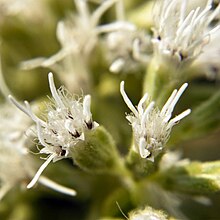Eupatorium altissimum
| Tall thoroughwort | |
|---|---|

| |
| Scientific classification | |
| Kingdom: | Plantae |
| Clade: | Tracheophytes |
| Clade: | Angiosperms |
| Clade: | Eudicots |
| Clade: | Asterids |
| Order: | Asterales |
| Family: | Asteraceae |
| Genus: | Eupatorium |
| Species: | E. altissimum
|
| Binomial name | |
| Eupatorium altissimum L. not (L.) L.
| |
| Synonyms[2] | |
|
Synonymy
| |
Eupatorium altissimum, with the common names tall thoroughwort and tall boneset, is a perennial herbaceous plant in the Asteraceae family with a native range including much of the eastern and central United States and Canada. It is a tall plant found in open woods, prairies, fields, and waste areas, with white flowers that bloom in the late summer and fall.
Description[edit]
Eupatorium altissimum is a perennial herb sometimes more than 150 cm (5 feet) tall.

Leaves and stems are covered with whitish hairs. Leaves are opposite on the stem and either are sessile or have very short petioles. They are narrow, 5–12 centimetres (2–5 in) long and 8–30 millimetres (0.3–1.2 in) wide.[2] Leaves are lanceolate with 3 prominent veins underneath and teeth appearing only above the middle of the leaves.[3]
E. altissimum produces a large number of small dull white flower heads in a large flat-topped array at the top of the plant. Each head generally has 5 disc florets but no ray florets.[4]
The species is often confused with Brickellia eupatorioides (false boneset) because the flowers look similar and because both grow on limestone soils. However, the leaves of E. altissium are opposite with 3 prominent veins, while the leaves of B. eupatoioides are alternate with 1 prominent vein. Also, E. altissium flower heads consist of 5 florets, while the flower heads of B. eupatorioides have 6 to 15 florets.[5]
Taxonomy[edit]
Eupatorium altissimum is part of Eupatorium even when that genus is defined narrowly to include about 40 species of mostly white-flowered plants of North America, Asia, and Europe.[6][7]
Distribution and habitat[edit]
E. altissimum is native to eastern and central North America, from Ontario in the north, Nebraska in the west, Texas and the Florida Panhandle in the south, and Massachusetts in the east.[8] It almost always grows on limestone soils in prairies, open woods, fields, and neglected areas.[3]
Ecology[edit]
The plant blooms from August to October.[3] It attracts various pollinators and is a larval host plant for Schinia trifascia (three-lined flower moth).[9]
It can hybridize with Eupatorium serotinum.[4]
References[edit]
- ^ "Eupatorium altissimum". NatureServe Explorer. NatureServe. Retrieved 2022-11-02.
- ^ a b "Eupatorium altissimum L." www.worldfloraonline.org.
- ^ a b c Denison, Edgar (2017). Missouri Wildflowers (Sixth ed.). Conservation Commission of the State of Missouri. p. 50. ISBN 978-1-887247-59-7.
- ^ a b Siripun, Kunsiri Chaw; Schilling, Edward E. (2006). "Eupatorium altissimum". In Flora of North America Editorial Committee (ed.). Flora of North America North of Mexico (FNA). Vol. 21. New York and Oxford: Oxford University Press – via eFloras.org, Missouri Botanical Garden, St. Louis, MO & Harvard University Herbaria, Cambridge, MA.
- ^ "Eupatorium altissimum". iowaplants.com.
- ^ Gregory J. Schmidt and Edward E. Schilling (2000). "Phylogeny and biogeography of Eupatorium (Asteraceae: Eupatorieae) based on nuclear ITS sequence data". American Journal of Botany. 87 (5): 716–726. doi:10.2307/2656858. JSTOR 2656858. PMID 10811796.
- ^ Siripun, Kunsiri Chaw; Schilling, Edward E. (2006). "Eupatorium". In Flora of North America Editorial Committee (ed.). Flora of North America North of Mexico (FNA). Vol. 21. New York and Oxford: Oxford University Press – via eFloras.org, Missouri Botanical Garden, St. Louis, MO & Harvard University Herbaria, Cambridge, MA.
- ^ "USDA Plants Database". plants.usda.gov.
- ^ Robinson, Gaden S.; Ackery, Phillip R.; Kitching, Ian; Beccaloni, George W.; Hernández, Luis M. (2023). "HOSTS - The Hostplants and Caterpillars Database at the Natural History Museum". www.nhm.ac.uk. doi:10.5519/havt50xw.

